Halebidu is a small town in Karnataka, India. It is almost 35km from Chikkamagaluru, 30km from Hassan and 210km from Bangalore. The Hoyasaleswara Temple is the major attraction of this town. Halebidu was the capital of the Hoysala Empire. Thus when we were visiting Chikkamgaluru a few weekends back, we also explored the Hoysaleswara Temple (often known as the Halebidu temple). While on our way back from Chikkamgaluru to Bangalore, we stopped here. Since, after having explored the temples on our previous trip to Hampi, a day trip to Kolar and another one to Lepakshi, we have totally fallen in love with the ancient temples of India. And we get totally mesmerized by their brilliant architecture. So, we were excited since the beginning on the possibility of visiting the Hoysaleswara Temple (Halebidu temple) on one of our several road trips in India, on our way from Chikkamagaluru to Bangalore.
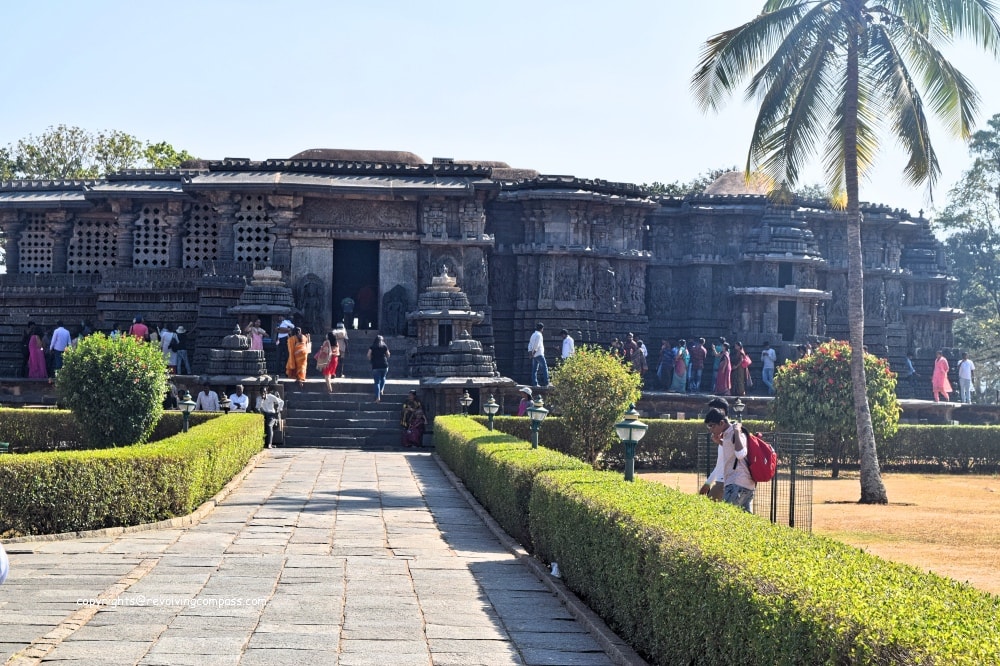
Table of Contents
History of Halebidu Temple
The Halebidu Temple is a hindu Temple. It was constructed in the 12th century. And it is dedicated to the Hindu God Lord Shiva. King Vishnuvardhana of the Hoysala Empire sanctioned the plans to construct this temple. Thereafter the construction of the Halebidu temple started in 1121 CE. Finally, it was completed in 1160 CE. But, later, around the 14th century, the empire fell to the attack of the muslim kingdom from Delhi. And at that point of time, this temple also got ruined. However, the artwork of the temple remained largely intact. And that is the major attraction for the visitors now. Since, there is no dedicated inscription found in the temple (it is believed to have been lost). Yet, it’s history is derived based on some inscription found almost 5km from the temple.
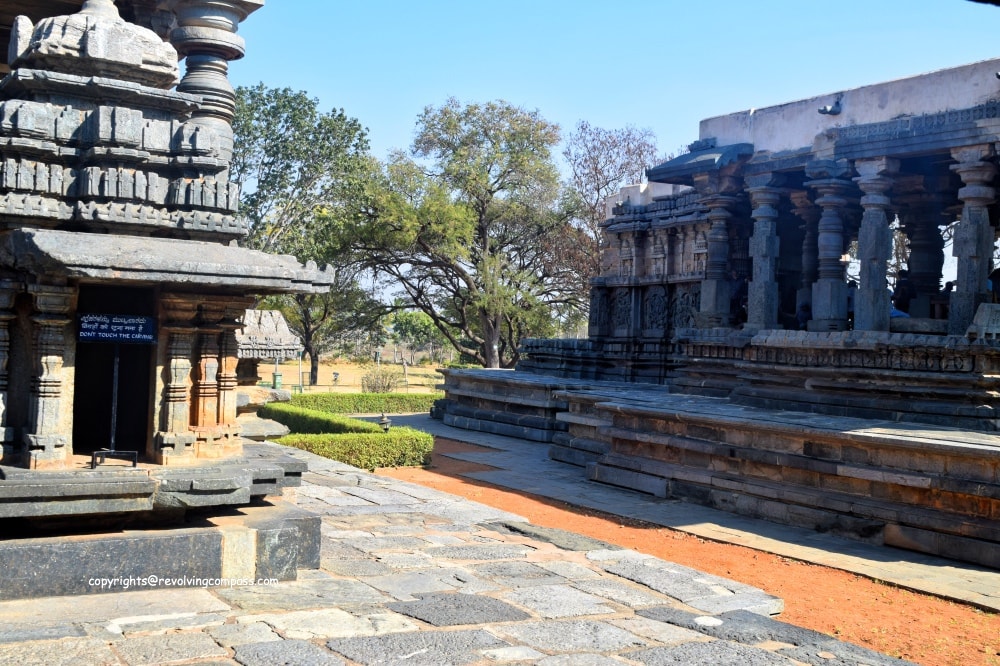
Based on the inscription, it is believed that there were several other temples. And these included other Hindu and Jain temples built around the main Halebidu temple. And several ruins of the Hoysala architecture can be seen around the temple. The Halebidu temple along with these other ruins and set of ancient temples around it are declared protected monument. And these are also proposed to be included in a list of UNESCO World heritage sites. And in fact, it is one of the most beautiful ancient temples of India.
You might as well like : A drive to Gandikota and Belum Caves from Bangalore
Construct of the Halebidu Temple
Although the temple is a Shiva temple. Still, influence of other traditions including Vaishnavism, Shaktism and Jainism can also be seen by and large on the temple. There are very intricate carvings on all the walls of the temple. Most of these depict the lifestyle from the 12th century. And legends from the epics like Ramayana and Mahabharta are also carved on the temple walls. Overall, the temple is made of soapstone (metamorphic rock). Alongside the intricate carvings and depictions of legends, the temple is also rich in iconography and inscriptions in both North Indian and South Indian scripts.
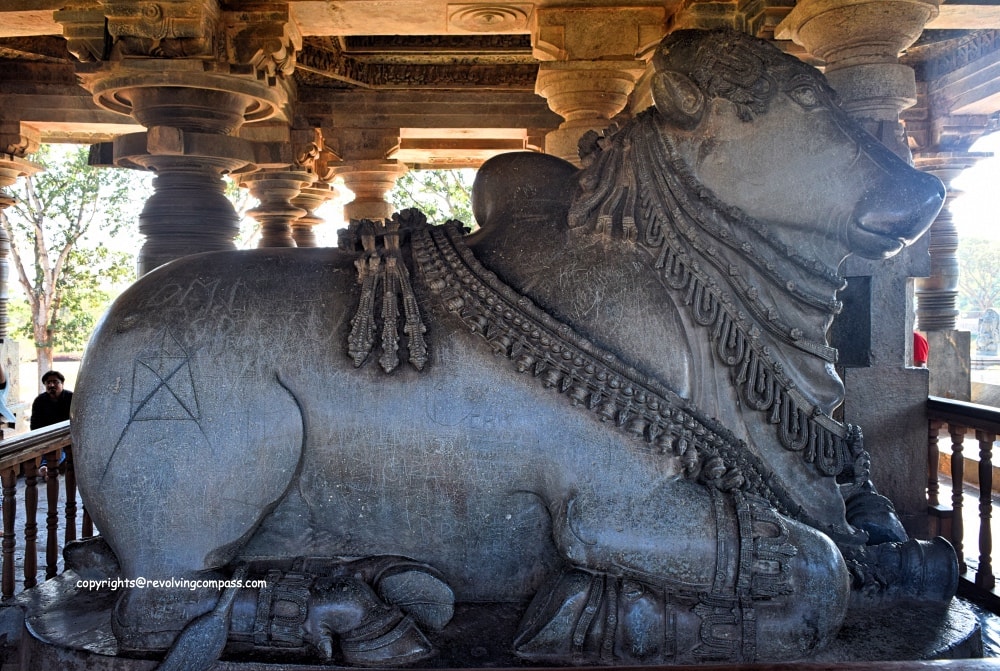
The concept of Twin Temples
The Halebidu temple is actually a twin temple. A twin temple consists of two shrines and two superspectrums. And these two are connected with each other. Furthermore, Each one of the temples contains a Shiv linga. The twin temples of Halebidu temple are believed to be dedicated to Hoysaleswara and Santaleswara Shiva lingas. These shiv lingas are named after the masculine and feminine aspects. And they are both equal and joined at their transept. It is said that while the king offered prayers to the masculine form. The queen worshipped the feminine one. Outside each of the twin temples, there is a Nandi shrine. With a huge statue of the Nandi facing the Shiv linga in the respective temple that it faces. One has to climb down the stairs of the main temple with the Shiv Linga. And then climb up the stairs of the Nandi shrine to visit it.
The temples open towards the east. However, now the campus of the temple is built in a way that the entrance to the shrine happens from the north door. The shrines are star shaped. And they are connected with each other at one end of the shrine.
Carvings on the Halebidu temple wall
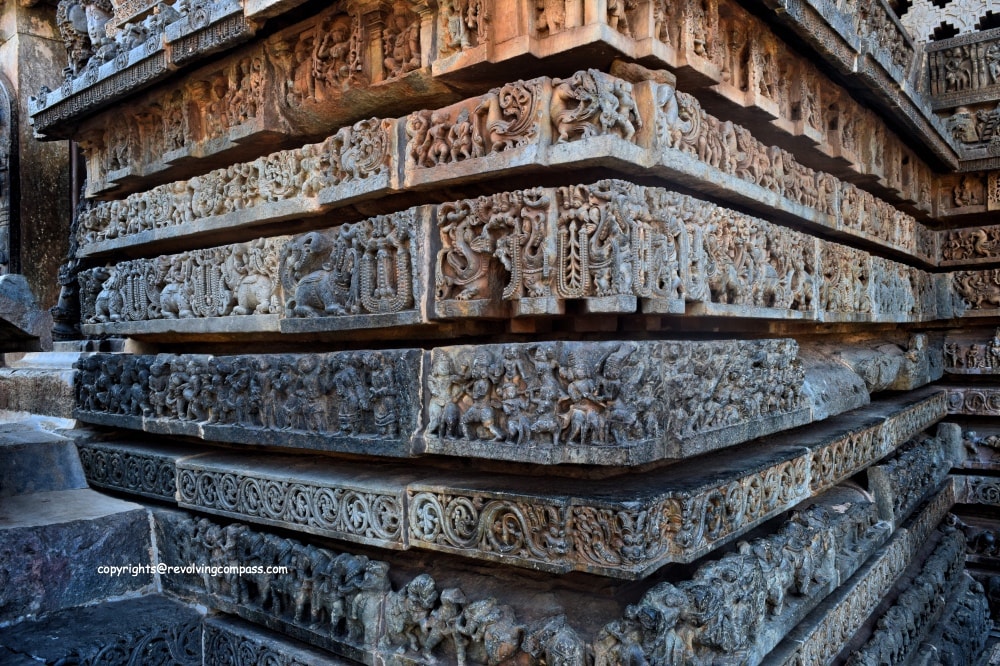
The outer walls of the Halebidu temple have very intrinsic carvings. The lowest layers consist of animal figurines like elephants, horses, lions etc. Then they are followed by miniature carvings of dancers, friezes narrating legends from the Hindu texts, makaras, peacocks. Thereafter, one can see the depictions of daily life of people in the next few layers of carving, including festivals. Also, ceremonies, mythical creatures, people standing and sitting etc are depicted in this layer. Then one can see different carvings depicting artha, kama, dharma scenes including courtship and eroticism. Thereafter there are large panels with bigger figurines depicting the deities of Hindu culture, and the mythical scenes from different epic stories.
One can see scenes like Durga killing a buffaloo. Or, Rama and his brothers going on an exile. And also Arjuna and Krishna episodes from Mahabharata and several other scenes. Take sufficient time when you visit here, have a look at the carvings and try to decipher which story you can relate them to 🙂
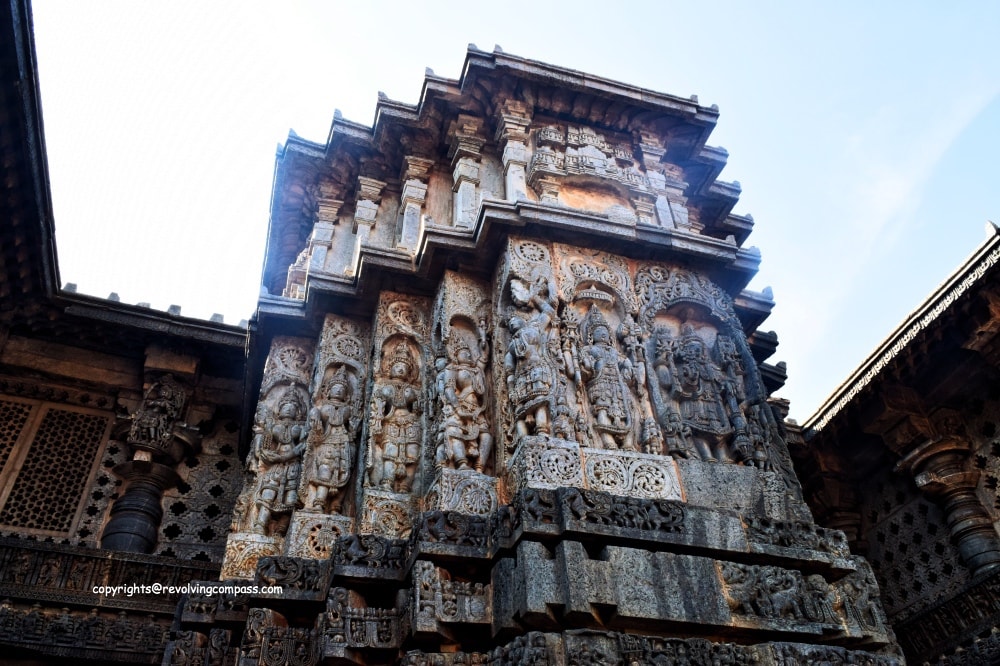
Halebidu temple interiors
The interiors of the Halebidu temple are as beautiful as the outer walls. There are 4 entrances to each of the temple shrine. And the doors also had two doorkeepers statues on either side. While one of the doorkeeper statue is intact. But, some are damaged and one is completely missing. Across the north and south entrance, pillars run on either side in parallel inside the temple. Most of these pillars are also plain. And so are the walls. Particularly when compared to outside walls. But the four pillars right in front of the shrine have carvings on top of them.
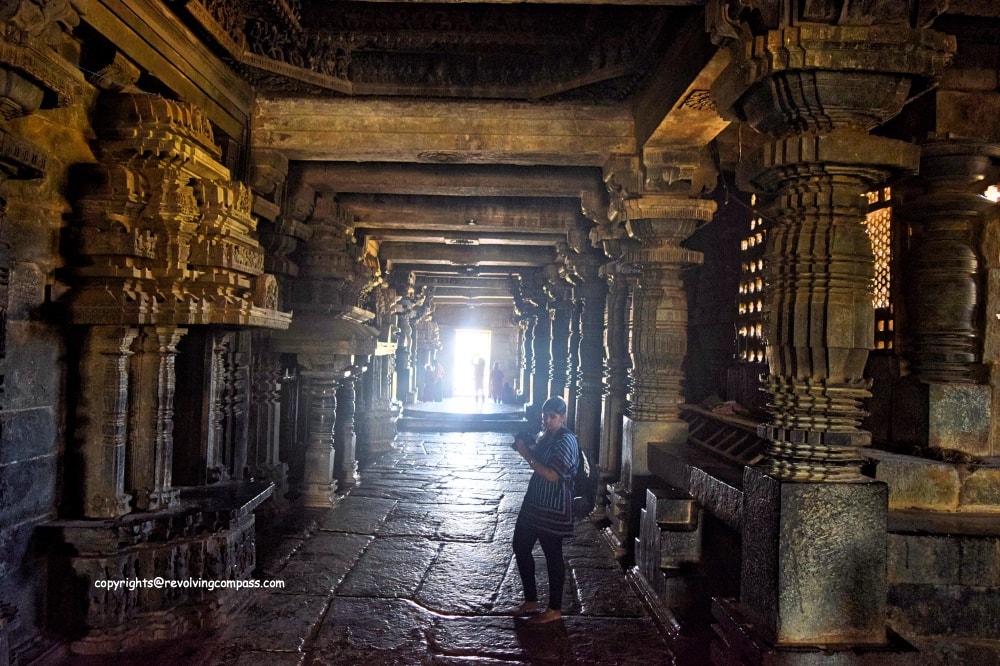
Halebidu Temple campus
There is a museum also in the Hoysaleswara temple premises. It is managed by the department of archeological survey of India. It consists of different ruins and pieces that were later recovered from around the temple. And some of these were once a part of the temple. Also, a little further to the main shrines is a statue of Lord Ganesha. Then there is a Garuda Stambha towards the south of the temple. Further, there is Surya (Sun) monument towards the east of one of the nandi shrines. And a Chandra monument near the other nandi shrine. Also, there are other God shrines inside the temple premises.
Overall the Halebidu temple is considered a marvellous and outstanding example of the rich Hindu architecture. The kind of labor that has been put to build this temple. And the kind of intricate work that is depicted in this temple is believed to surpass any form of Gothic art.
Do take a guided tour of the Halebidu Temple and other nearby temples to understand the carvings and the story or mythology depicted in each one of them.
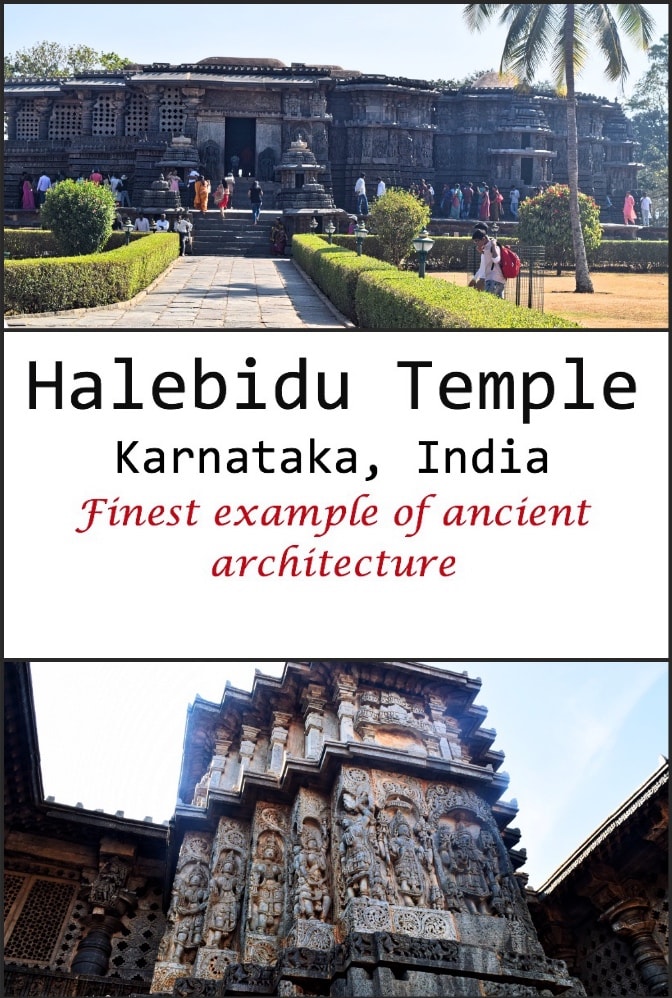
Hi Neha, nicely you summarized each detail of the Halebidu Temple. I had visited these temple 4-5 years back with parents on the way to Chikmagalur. Your post refreshed all the memories. Loved the pictures.
Thank you! The temple is indeed one of the best works of art that I have seen
Hi,, can i get best weekend getaways from Bangalore in one article with list of places
Hi Ravi, there are many such articles present on the internet if you search for “best weekend getaways from Bangalore”. Have you checked some of them out? Also, are you looking for some specific type of places? You could drop us a mail if you are looking for something specific. We would be happy to help.
The more said about Hoyasaleswara temple, the less. I was spellbound when I visited it for the first time. I spent all day studying the details. The temple at nearby Belur is also amazing. You documented it so well.
Thanks Abhinav. Yes, Belur Temple is also very beautiful. We loved both the temple architectures.
Halebidu reminds me a lot of the Angkor Wat temple in Cambodia. It’s amazing how structures that share similar features exist in different places. I am quite taken by the carvings, how intricate they are, and the sheer number of them, really makes you wonder how they were able to create them back in the day. Hindi architecture is one of the most impressive there is. I would love to explore Halebidu when given a chance.
The carvings of the temple of Halebidu are really very intricate. You will definitely like it.
I’ve visited Hampi, Badami, Pattadakkal, and Aihole, but did not know about Haledibu. The temples of Karnataka are truly spectacular architecturally and in their sculptural beauty. Now I have one more place to visit in Karnataka.
You have visited a lot of beautiful temples in Karnataka. And yes, you will definitely like the temple of Halebidu as well
The architectural designs of the temple as well as the historical significance of the artefacts on display look absolutely amazing. I’d love to visit.
This temple’s architecture as well the carvings are very unique.
Amazing Blog Post.
Amazing! The cravings on the temple walls..it is really beautiful!
I absolutely love your blogs about India. I recently went to Bali and I really enjoyed seeing how Hinduism has shaped their daily lives. Just the tiniest details of offering flowers and fruits amazes me. Even more with their temples — very intricate!
Thank you so much! It’s really amazing how travel brings us closer and helps us appreciate other cultures, isn’t it?
The temples of India are so varied and architectural masterpieces that it is difficult to not fall in love with the,. The temple at HAlebidu is really a masterpiece. We had visited the temple while returning from Chikkamagalur, but had so less time to explore it. We would wish to visit there again. Loved your post about the temple.
I’ve been to Halebidu, and was utterly charmed by the temple. The architecture here is stunning, the history fascinating. Great post!
This temple looks incredible. Gems not that visited by other travellers wow. Really happy to discover places like this!
The Hoysaleshwara Temple at Halebidu is indeed a masterpiece in stone. have been there a couple of times and each time have found some new and fascinating aspect of the temple. The museum on the sidelines of the temple is another intriguing place that is so enthralling.
We could literally spend days studying the depictions and carvings here. Whole epics have been depicted through minute work on the temple walls!!